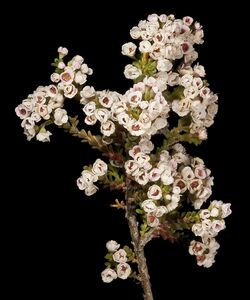Biology:Scholtzia parviflora
| Scholtzia parviflora | |
|---|---|

| |
| Scholtzia parviflora flowers | |
| Scientific classification | |
| Kingdom: | Plantae |
| Clade: | Tracheophytes |
| Clade: | Angiosperms |
| Clade: | Eudicots |
| Clade: | Rosids |
| Order: | Myrtales |
| Family: | Myrtaceae |
| Genus: | Scholtzia |
| Species: | S. parviflora
|
| Binomial name | |
| Scholtzia parviflora F.Muell.
| |
Scholtzia parviflora is a shrub species in the family Myrtaceae that is endemic to Western Australia.[1]
The shrub typically grows to a height of 1 to 3 metres (3.3 to 9.8 ft).[1] The plant has a spreading habit with decumbent branches. The evergreen leaves have a length of 1 to 2 millimetres (0.039 to 0.079 in) and no prominent veins.[2] It blooms between August and October producing pink-white flowers.[1] The flowers have a diameter of around 5 mm (0.197 in) and are on pedicels about the same length as the leaves.[2] The plant superficially resembles Scholtzia uberiflora but is much more widespread.[2]
The species was first formally described by the botanist Ferdinand von Mueller in 1864 as part of the work Fragmenta Phytographiae Australiae. The only known synonym is Baeckea parviflora.[3]
It is found in wet depressions in the Mid West and Wheatbelt regions of Western Australia between Geraldton and Cunderdin where it grows in sandy soils over laterite.[1] It is part of the understorey in kwongan shrubland communities.[2]
References
- ↑ 1.0 1.1 1.2 1.3 "Scholtzia parviflora". FloraBase. Western Australian Government Department of Parks and Wildlife. https://florabase.dpaw.wa.gov.au/browse/profile/6037.
- ↑ 2.0 2.1 2.2 2.3 Margaret G. Corrick; Bruce Alexander Fuhrer (2009). Wildflowers of Southern Western Australia. Rosenburg Publishing. ISBN 9781877058844.
- ↑ "Scholtzia parviflora F.Muell.". Atlas of Living Australia. Global Biodiversity Information Facility. https://bie.ala.org.au/species/http://id.biodiversity.org.au/node/apni/2891339#names. Retrieved 6 November 2018.
Wikidata ☰ Q15381943 entry
 |

